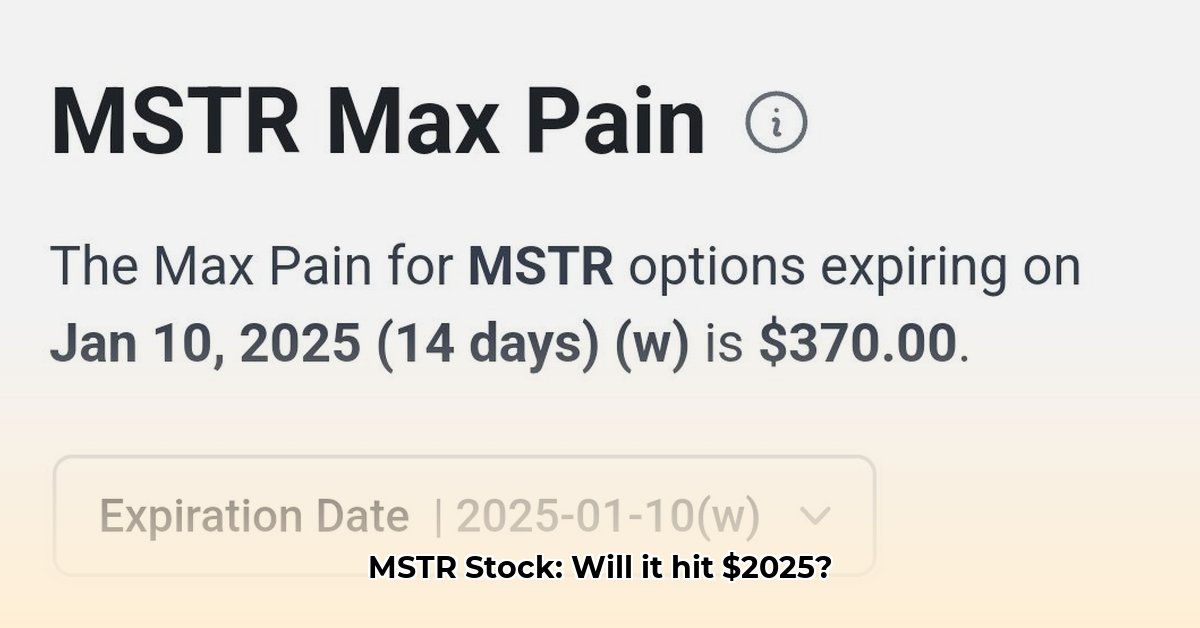
Understanding MSTR Max Pain and its Implications
Max pain, in the context of options trading, identifies the price at which the majority of options contracts expire worthless. Analyzing MSTR (MicroStrategy) max pain provides insights into market sentiment and potential price movements, offering valuable information for both short-term and long-term trading strategies. However, it's crucial to remember that max pain analysis is not a crystal ball; it's a tool to inform, not dictate, investment decisions. Understanding its limitations is as important as understanding its applications.
Short-Term Outlook: Navigating the Near-Term
For the upcoming months (February-March 2025), MSTR's max pain suggests a price range between $315 and $345. This indicates a relatively stable near-term outlook, according to current market expectations. This range offers a degree of predictability for short-term options trading strategies. This doesn't guarantee price stability, but it does provides a framework for informed decision-making. How can traders best leverage this narrow prediction?
Short-Term Strategies:
- Options Trading: Focus on strategies utilizing options with strike prices within the $315-$345 range. However, remain vigilant about potential volatility. Consider using protective puts if bearish expectations arise.
- Risk Management: Keep a close eye on the underlying price of Bitcoin since its volatility directly impacts MSTR. Employ stop-loss orders to limit potential losses if the price moves beyond a predetermined threshold.
Long-Term Outlook: Uncertainties and Challenges
Predicting MSTR's price beyond six months becomes significantly more challenging. Max pain predictions for this timeframe show a far wider range, from $67 to $440. This considerable uncertainty stems from several key factors. What are some of the biggest hurdles to accurate long-term prediction?
Factors Influencing Long-Term Price Volatility:
- Bitcoin's Price Volatility: MSTR's substantial Bitcoin holdings make its performance inextricably linked to the cryptocurrency's price fluctuations. Bitcoin's inherent volatility translates directly into a similar volatility for MSTR.
- Regulatory Uncertainty: The evolving regulatory landscape for cryptocurrencies presents a significant risk factor. New regulations could potentially have a profound impact on MSTR's valuation, making predictions difficult. How might these unpredictable regulatory changes affect MSTR's long-term prospects?
- Macroeconomic Conditions: General economic conditions, including interest rates and inflation, significantly affect investor sentiment towards technology stocks such as MSTR. A weakening economy might lead to decreased investor confidence and lower stock prices. Does the current macroeconomic environment favor a bullish or bearish outlook for MSTR?
Strategies for Different Investor Profiles
The optimal strategy for navigating MSTR's price volatility depends heavily on the investor's profile, time horizon, and risk tolerance. How can different investor types leverage max pain analysis effectively?
| Stakeholder | Short-Term Strategy (0-6 Months) | Long-Term Strategy (6+ Months) |
|---|---|---|
| Options Traders | Targeted strategies around the $315-$345 max pain range, but with caution and risk management. | Proceed with extreme caution; long-term options are highly risky. Diversification is imperative. |
| Institutional Investors | Close monitoring of short-term price movements and Bitcoin's performance. | Fundamental analysis is critical, considering macroeconomic factors and potential regulatory shifts. |
| MicroStrategy Management | Transparency regarding Bitcoin holdings and risk management strategies. | Focus on long-term strategic planning to mitigate risks and maximize opportunities. |
Mitigating Risk: Practical Steps for Investors
Regardless of your investment strategy, managing risk is paramount when dealing with the volatility inherent in MSTR. What are the most critical risk mitigation strategies?
- Diversification: Never concentrate your investments solely on MSTR. Diversification across different asset classes reduces your exposure to significant losses from fluctuations in MSTR's price.
- Hedging Strategies: Consider implementing hedging strategies such as protective puts to mitigate potential downside risk. These strategies can cushion potential losses.
- Risk Tolerance: Before investing, carefully assess your risk tolerance. Never invest more than you can afford to lose. Understanding your own risk profile is critical before making investment decisions.
Conclusion: The Importance of Continuous Monitoring
MSTR's max pain analysis offers valuable insights into potential price movements but should not be interpreted as definitive predictions. The inherent uncertainties associated with Bitcoin's price, regulatory changes, and macroeconomic conditions demand a cautious approach. Continuous monitoring, robust risk management, and a thorough understanding of your own investment goals are critical for success in navigating the complexities of MSTR trading. The dynamic nature of the market requires constant adaptation and vigilance.